Your safety is BART’s top priority, and we don’t take this responsibility lightly. Uncompromising safety standards and the participation of our most important safety partner—you—help keep BART safe and secure.
BART has invested significantly in safety-related improvements in stations and onboard our trains. BART has plans that cover virtually every conceivable emergency, working with local police, fire departments and other emergency agencies. BART holds practice drills and conducts training with first responders on a regular basis.
BART safety also includes informing our customers about how BART safety features and policies work, how to avoid hazards and how to become an active partner in ensuring your own safety.
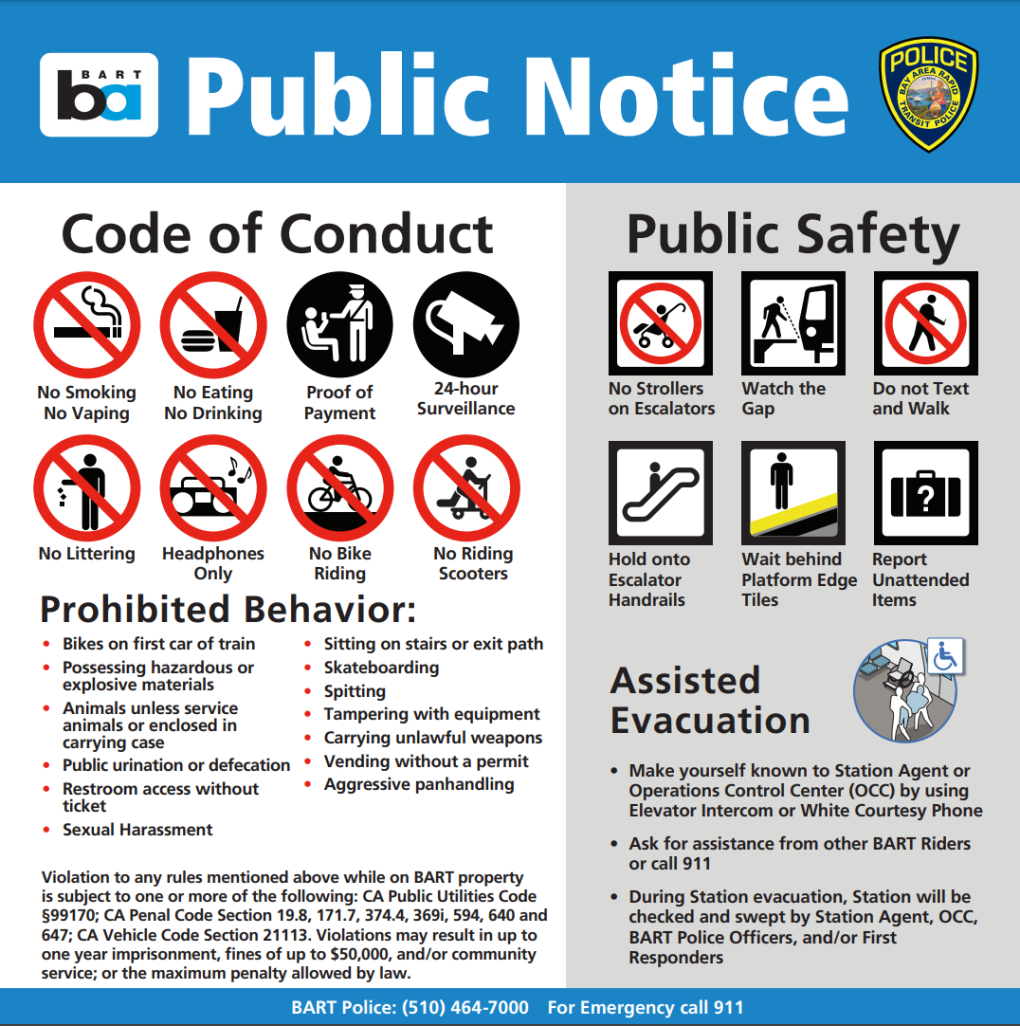
Click on the following links to be directed to the section below on this webpage:
Safety Rules As Simple As 1-2-3
General Safety
Safety Rules As Simple As 1-2-3
Being safe can be as simple as these three steps...
- Be aware of your surroundings. Knowing that something doesn't look "right" can sometimes make the difference in your safety.
- Pay attention to emergency instructions. A trained BART employee issuing instructions is a critical emergency resource. Whether you are on the train and receiving instructions over an intercom, or face-to-face with a Station Agent or a BART Police Officer, please pay attention and follow directions calmly.
- Report or act upon an unsafe condition immediately. Reporting an unsafe incident or condition to BART personnel can protect you and others from a dangerous situation. If that's not possible, this brochure contains some specific instructions for emergency situations.
General Safety
At The Station
Watch your step on stairs and escalators. Hold onto handrails. Be careful to avoid wet areas or debris and report unmarked hazards to the Station Agent.
Avoid using your mobile device or mobile phone, texting or other multitasking while walking.
At stations, do not cross the tracks, walk on the trackways or touch the electric third rail.
Do not run in stations, on trains or on platforms. Running significantly increases the risk of injuries to you and other passengers.
For security reasons, hold onto your luggage and personal possessions at all times.
Roller skating, roller blading, bicycle riding and skateboarding are not allowed in stations or on trains. When carrying bikes, be aware of other passengers. Permits are required for (electric only) motorized scooters/two-wheeled vehicles.
Smoking or vaping is prohibited in stations or on trains.
Gasoline, flammable or volatile solvents, acids, or hazardous or explosive materials are not allowed in stations or on trains.
On The Escalator
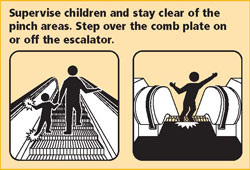
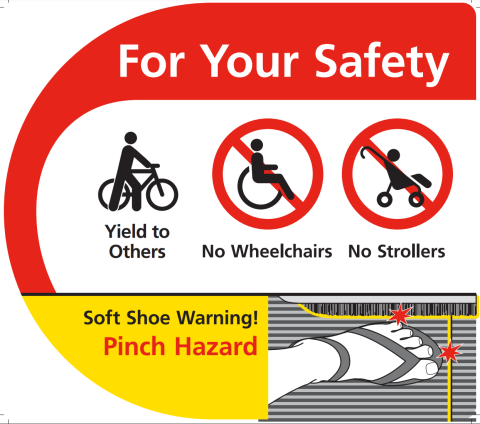
Safe use of escalators requires observing the following critical rules.
Please Pay Attention:
• Look at the direction of the escalator before you take the first step.
• Watch your step when entering or leaving the escalator, and step (don’t slide) off.
• Keep your feet in the center of the step and face forward.
Use the Handrail
• Always use the handrails to maintain your balance.
• NEVER ride or place bags or luggage on the handrail.
Exit Promptly
• Do not block the escalator landing.
• NEVER stop, stand or play on an escalator landing.
Supervise Children
• Hold the hands of small children.
• Carefully supervise children who are in your care so that they do not sit or play on stairs or escalators.
Stay Clear of Pinch Areas
• Keep your hands, feet and clothing clear of the side panels of the escalator.
• Be careful—loose shoelaces, soft rubber shoes and baggy clothes can get caught in the moving parts of the escalator.
Step over Comb Plate
• Always pick up your feet and step carefully on or off the escalator. NEVER drag or slide your feet off the edge of the escalator.
Please Don't Use the Escalator If...
• You have limited physical abilities or are carrying large packages or luggage.
• You are using a wheelchair, walker, or other mobility device.
• You are carrying a small child in your arms or in a stroller.
• Animals are not allowed on escalators.
On The Platform
- Please stay behind the yellow platform edge detection tiles. Do not approach the train until it comes to a complete stop in the station.
- Never sit on the platform edge or touch the outside of the trains!
- Do not cross the tracks or enter the trackway under any circumstances!
- If you drop something on the trackway, do not attempt to retrieve it! Contact the Station Agent for help.
- There is a crawl area underneath the train platform that may provide some protection in the event of an accidental fall onto the track.
- Watch your step when boarding and watch the narrow gap between the platform edge and the train.
- Stand in the center of the platform and in well-lighted areas.
- If you need help, use a white courtesy phone to contact a Station Agent. For police assistance, call the Station Agent, go to the nearest pay phone or use your mobile phone and dial (510)464-7000.
- BART train doors close automatically. Doors do not reopen for obstructions. Please keep yourself and your possessions well clear of the doors upon entering and exiting the train.
- Station platform edges have special rubber tiles and a noticeable change of texture to alert vision impaired passengers that they are approaching the edge. The tiles are bright yellow at the positions of the train's doors to aid passengers with limited vision.
- Take precautions while near the space between train cars.
On The Train
- Do not lean against the doors when inside the train.
- When entering and exiting the train, be sure to watch your step. There is a gap of approximately three inches between the train and the platform.
- Flammable liquids are not allowed in stations or on trains.
- There are three intercoms on each car
- Take time out to review the Emergency Evacuation and Safety Information Procedures signs posted on all of the trains.
- Please keep luggage out of the way of fellow passengers. Luggage must never block walkways and doorways. To help prevent tampering, theft or damage; keep luggage secure and within your sight.
In The Parking Lot
Observe all posted regulations and park in designated areas. Before leaving you car:
- Check your headlights,
- Lock your car
- Don't leave valuables or packages where they can be seen.
Using Emergency Equipment
Fire Extinguishers
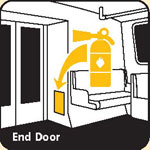
Emergency fire extinguishers are located on all levels of the stations and are well marked. In the event of an emergency, follow the instructions over the public address system or directly from BART personnel.
Intercom
- Locate the intercom on your train (there are three intercoms on each car).
- Press, then release, the red button to speak directly with the Train Operator.
- Use the intercom to ask the Train Operator questions or to report anything you believe is important or unsafe. Note the Car Number is directly above the intercom or at the ends of each Car.
- The Train Operator can contact the BART Control Center to provide whatever emergency or other services are needed.
- If something is happening in the car you are in and you don’t want to be seen calling the Train Operator, walk to the next car and call from there. You can also report it to BART Police using the BART Watch app, which is downloadable for Apple and Android phones.
Medical Emergencies
Calling for Help at the Station
In the event of a medical emergency in the BART station, contact the Station Agent by using the white courtesy telephone. If BART personnel are not immediately available, use your cell phone or go to the nearest pay phone and contact BART Police at (877) 679-7000. You will not have to deposit money in the phone.
Calling for Help on the Train
If a medical emergency occurs on the train, contact the Train Operator using either of the intercoms located at each end of the car. In Fleet of the Future cars, intercoms are located at 3 out of the 6 door locations.
Before Medical Help Arrives
Avoid moving the stricken person while you are waiting for trained personnel to arrive. Apply first aid to the level of your ability.
Evacuation Procedures
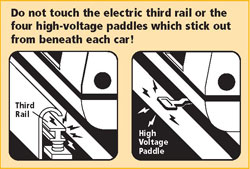
Overview
In an emergency, the safest place to be is usually onboard the train. By staying onboard you allow the Train Operator to choose from a number of actions to ensure your safety, including moving the train to a safe location, calling for additional emergency personnel, going to the reverse end and moving the train out of danger, and separating cars from the rest of the train. Do not evacuate unless instructed to do so by BART personnel or other emergency response personnel.
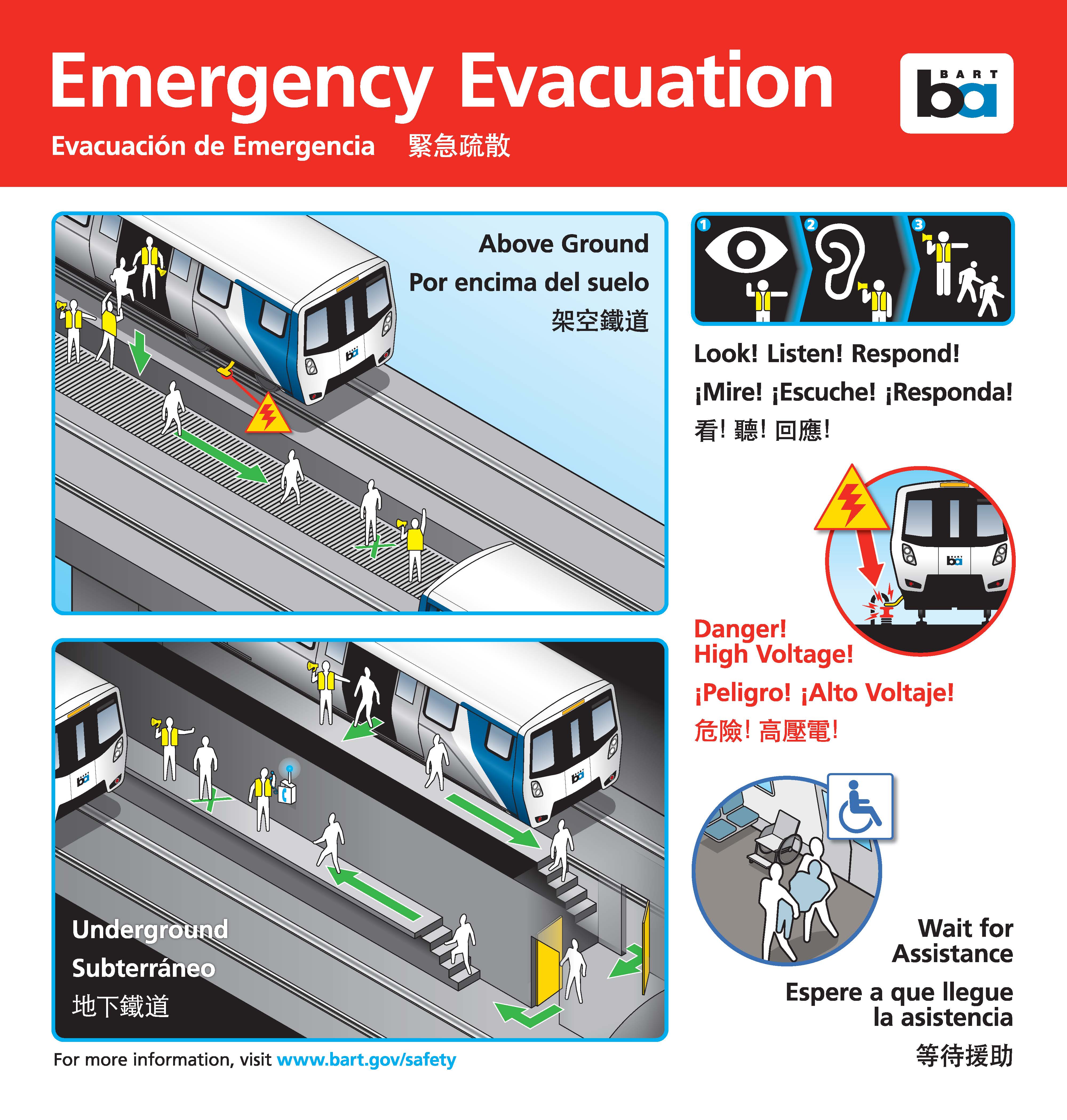
Evacuation procedures vary depending on whether the tracks are:
- Above ground
- Underground
Important Safety Notes
For all evacuation procedures that follow, there are three life-saving rules that must always be followed:
- Follow instructions from the Train Operator.
- Do not touch the electric third rail.
- Do not touch the four high-voltage paddles that stick out from beneath each car.
Emergency Door Release
An emergency door release is located next to each door.
• To open the door manually after the train stops, pull the cover panel away and pull the lever down.
• Use the door release only in emergencies. Remember, the safest place to be during an emergency is onboard the train in most cases.
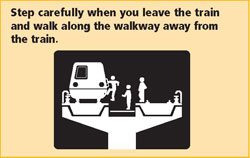
On An Elevated Track(Aerial Structure)
On aerial structures, also called elevated tracks, the walkway is approximately five feet below the level of the train. If you have to evacuate, the Train Operator will open a door that has handrails and inset footsteps outside the door. These doors are located on each car.
- Step carefully when you leave the train and walk along the walkway away from the train.
- Walk on the tracks or walkway far enough past the train so that people behind you can also get a safe distance from the train.
- Wait for help to arrive and for instructions from the Train Operator or rescue personnel.
- Please assist children, older passengers and people with disabilities.
Evacuation In A Subway
(Not Transbay Tube or Berkeley Hills Tunnel)
- When evacuating a train in a subway, the Train Operator will open the doors or you may open the doors yourself.
- An emergency door release is located next to each door. To open the door, pull the cover panel away and pull the lever down.
- When the doors open, look to see if there is a walkway.
- If there is no walkway, walk through the train to the next car and exit.
- Proceed along the walkway away from the train until you reach the nearest door.
- Cross through the passageway to the opposite tunnel and walk along the emergency walkway until people behind you have cleared the doorway.
Berkeley Hills Evacuation
If evacuation in the Berkeley Hills Tunnel is necessary, the Train Operator will open selected doors for your evacuation and give you instructions.
- Watch your step when exiting the train.
- Go along the walkway or trackway to the nearest door, cross through the passageway to the opposite tunnel and walk along the emergency walkway tracks until the people behind you have cleared the doorway.
- Wait for the rescue train.
- Do not block the doorway. Doors leading to the passageway are lighted and painted bright yellow and are located about every 1,000 feet.
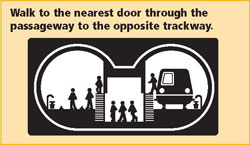
Transbay Tube Evacuation
If evacuation in the Transbay Tube is necessary, carefully step from the train to the walkway. If there is no walkway, walk through the train to the next car, then exit the train.
- Reflective signs on the wall indicate the distance and direction to the nearest door. Go along the walkway and down the ramp to the nearest door, go through the passageway to the opposite trackway, proceed along the walkway until people behind you have cleared the doorway.
- Wait for the rescue train.
- Do not block the doorway. Cross-passage doors are lighted and painted bright yellow and located every 330 feet.
Evacuation On Ground Level
Evacuation on ground level involves essentially the same procedures as for aerial evacuation - see section titled Evacuation on an Elevated Track (Aerial Structure).
- Wait for the Train Operator to open the doors.
- Once outside the train, walk to the wire fence and away from the train.
- Stay between the fence and trackway until help arrives.
- Do not touch the electric third rail or the four high-voltage paddles which stick out from beneath each car!
- Help those who need assistance.
Emergency Phones
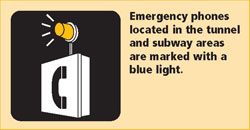
Emergency phones are located in the tunnel and subway areas and are marked with a blue light. Pick up receiver for a direct line to the BART Control Center.
Passengers With Disabilities
Assisted Evacuation on a Train
In case of an emergency, leave your wheelchair on the train. The walkways and ramps used for evacuation are too narrow to accommodate wheelchairs.
Passengers who are vision- or hearing-impaired or who use mobility aids should ask for assistance from other passengers.
During train evacuations, the train will be checked and swept by the Train Operator, BART Police or first responders. Rescue personnel will assist persons with disabilities
Assisted Evacuation in a Station
Make yourself known to a Station Agent or the Operations Control Center by using the Elevator Intercom or White Courtesy Phone and call boxes inside stations.
Ask for assistance from other BART riders or call 911.
During station evacuations, the station will be checked and swept by the Station Agent, BART Police or first responders. Rescue personnel will assist persons with disabilities.
ADA Mobility Device Reunification
In the event a rider is separated from their mobility device due to a train or station evacuation they should call BART Police Dispatch at 510.464.7000 to request assistance in reunifying with their device.
Security Measures
The BART Police Department is dedicated to ensuring the safety and security of BART customers, employees and their property. The BART security program is designed for maximum effectiveness without compromising on-time performance and protection of your privacy. Here are a few important guidelines regarding security on BART.
Personal Safety
• Always be alert and aware of the people around you.
• Avoid talking to strangers, especially in isolated areas.
• If carrying a purse, hold it tightly and close to your body; if carrying a wallet, keep it in a front pocket.
• If you are attacked, scream or blow a whistle in order to bring attention to your situation.
While Riding BART
In the event of a problem, follow all instructions from BART Police and station personnel carefully.
Keep your packages, briefcases, backpacks, etc. with you at all times.
If you see an unattended package, leave it where it is, move away and call BART Police at (510) 464-7000 or contact a Station Agent or Train Operator.
Familiarize yourself with station exits and the locations of fire extinguishers, station intercoms and pay phones.
When waiting for a train, stay in a central location that is occupied by other patrons.
During off hours, ride as near to the Train Operator as possible. If someone bothers you, move to another seat or car and notify the Train Operator.
If you are on a train, Train Operators can be contacted by using the intercom at each end of every train car. Train Operators can radio messages to the BART Police Department. Police officers can then be dispatched to any location.
If you are on a platform or inside a station, you may use a white courtesy telephone that goes directly to the Station Agent. The Station Agent can then contact the BART Police Department.
In the Parking Lot
Briskly and confidently walk to your vehicle. Scan the area as you walk and be aware of the people in the area. If anyone looks suspicious, move away from them. Go back to the station and notify the Station Agent.
Have your keys out and ready before you reach your vehicle. Once you have reached your car, quickly check the interior for any possible intruders. If clear, enter the car and quickly lock the door behind you.
Bike Safety
Bikes are never allowed on crowded cars. Bicyclists must do the following:
- use elevators, stairs or escalators,
- walk bikes,
- yield priority seating to seniors and people with disabilities,
- yield to other passengers,
- hold bikes while on trains or secure them, and do not block aisles or doors.
- In the case of evacuation, leave your bike on the train and do not let it block aisles or doors.
- Gas powered vehicles are never permitted.
For a complete list of bike rules and regulations, please visit the Bikes on BART section and check posted signs in stations and on trains.
Important Phone Numbers
Remember, there are four main ways to call for help:
- The white courtesy telephone, in the station
- The intercom, on the train
- BART Police is available at (510)464-7000 on your mobile device or phone
- BART Police can also be reached via text using the BART Watch App on your mobile device or phone
Safety Quick Reference
Emergency Phones:
Emergency phones located in the tunnel and subway areas are marked with a blue light. Pick up receiver for a direct line to the BART Control Center.
Fire Extinguishers:
Each car is equipped with two fire extinguishers located next to the doors connecting the cars. Signs mark their locations and instructions for their use are clearly stated.
Intercom:
There are three intercoms on each car.
Emergency Door Release:
An emergency door release is located next to each door. To open the door, pull the cover panel away and pull the lever down.
Third Rail:
Never touch the electric third rail or the four high-voltage paddles which stick out from beneath each car.
Emergency Evacuation:
In case of emergency evacuation, rescue personnel will assist passengers with disabilities. If you need assistance with evacuation, make yourself known by using Elevator Intercom or White Courtesy Phone. If evacuation is necessary before rescue personnel arrive, please assist passengers with disabilities. Leave wheelchairs on the train.
Aerial Structures:
Aerial or elevated structures have sunken walkways between the tracks. Step carefully! There is an extreme danger from the high-voltage paddles protruding from beneath each car. Do not touch the paddles! There are four paddles beneath each car, one near each pair of wheels.
Bicycles And Luggage:
Leave bicycles and luggage behind in the event of an emergency.